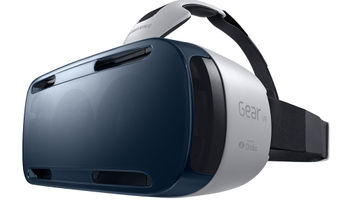Samsung Gear VR Innovator Edition
| Samsung Gear VR Innovator Edition | |
|---|---|

| |
| Basic Info | |
| Type | Virtual Reality |
| Subtype | Head-mounted Display |
| Platform | Oculus Rift |
| Developer | Samsung, Oculus VR |
| Manufacturer | Samsung |
| Release Date | December 8, 2014 |
| Price | $199, $249 with gamepad |
| Website | Samsung Gear VR Website |
| Versions | Samsung Gear VR for Note 4, Samsung Gear VR for S6/S6 Edge |
| Requires | Galaxy Note 4, Galaxy S6, Galaxy S6 Edge |
| System | |
| Operating System | Android |
| Storage | |
| Display | |
| Display | 5.7 inch Super AMOLED (RGBG PenTile) |
| Resolution | 2560 x 1440, 1280 x 1440 per eye |
| Refresh Rate | 60 Hz Low-persistence |
| Image | |
| Field of View | 96° (nominal) |
| Optics | |
| Tracking | |
| Tracking | 3DOF |
| Rotational Tracking | Accelerator, Gyroscope, Magnetometer |
| Update Rate | Rotational: 1000 Hz, high accuracy |
| Latency | Motion to Photon: Less than 20 ms |
| Audio | |
| Audio | 3D Spatial Sound |
| Camera | High Frame Rate Preview (60fps) |
| Connectivity | |
| Connectivity | microUSB to Galaxy Note 4 |
| Device | |
| Input | Touch Pad, Back Button, Volume Key |
| Size | 198mm x 116mm x 90mm |
Samsung Gear VR is a Virtual Reality head-mounted display developed by Samsung and Oculus VR. It is Oculus Rift's first mobile device. To use Samsung Gear VR, the user needs to mount a Galaxy Note 4, Galaxy 6 or Galaxy 6 Edge inside it. The smartphone serves not only as Gear VR's screen but also as its computer. Even though it requires Galaxy Note 4, Gear VR has Oculus Rift's head-tracking technology built within, allowing it to quickly and accurately track head movements. This technology differentiates Gear VR from the likes of Google Cardboard. The latter relies on smartphone's sensors to track head movements, which are less accurate and has higher latency. Unlike the Oculus Rift, Gear VR is completely mobile. It doesn't need to be connected to a computer.
Hardware
Constructed from plastic outer on the outside and soft cushion on the inside, Gear VR looks like a pair of bulky laboratory goggles. It requires Galaxy Note 4 as its display and source of computation. The smartphone is clipped to the front of the goggle. A pair of lenses focuses the user's vision similar to that of Google Cardboard. There is a strap that wraps around your head and another that goes on top of your head.
Gear VR utilizes the 5.7 inch low-persistence AMOLED display of Samsung Galaxy Note 4. It has resolution of 2560 x 1440 or 1280 x 1440 per eye. Note that it uses exactly the same display as Oculus Rift Development Kit 2.
Equipped with Oculus VR sensors, Gear VR tracks the user's head movements precisely. Users can interact with the device with a touchpad and a back button on the right of the headset. Additionally it has a wheel that adjusts the focus and another that changes the volume.
Specifications
Head-Mounted Display:
| Part | Spec |
|---|---|
| Field of View | 96° (nominal) |
| Dimensions | 198mm (width) x 116mm (length) x 90mm (height) |
| Interpupillary Distance | 55-71 mm |
| Sensors | Accelerator, Gyrometer, Geomagnetic, Proximity |
| Tracking | 3 degrees of freedom (rotational) |
| Update Rate | Rotational Tracking: 1000 Hz, high accuracy |
| Latency | Motion to Photon Latency: Less than 20ms |
| Focal Adjustment | Covers Nearsighted / Farsighted Eyes |
| Input | Touch Pad, Back Button, Volume Key |
| Connectivity | microUSB connection to the Galaxy Note 4 |
Galaxy Note 4:
| Part | Spec |
|---|---|
| Display | 5.7 inch Quad HD Super AMOLED |
| Resolution | 2560 × 1440 (1280 x 1440 per eye) |
| Refresh Rate | 60 Hz Low-persistence |
| Camera | High Frame Rate Preview (60fps) |
| Audio | 3D Spatial Sound |
- Specifications are from official website [1]
Galaxy S6
Galaxy S6 Edge
Apps
TheBluVR, Oculus Cinema, Milk VR, Oculus 360 Photos, and Oculus 360 Videos.
Developer
Oculus Mobile SDK
Oculus Mobile SDK is initially developed for Gear VR.
History
Samsung Gear VR was announced on 9/3/2014. It was released on 12/8/2014 for $199 dollars.

